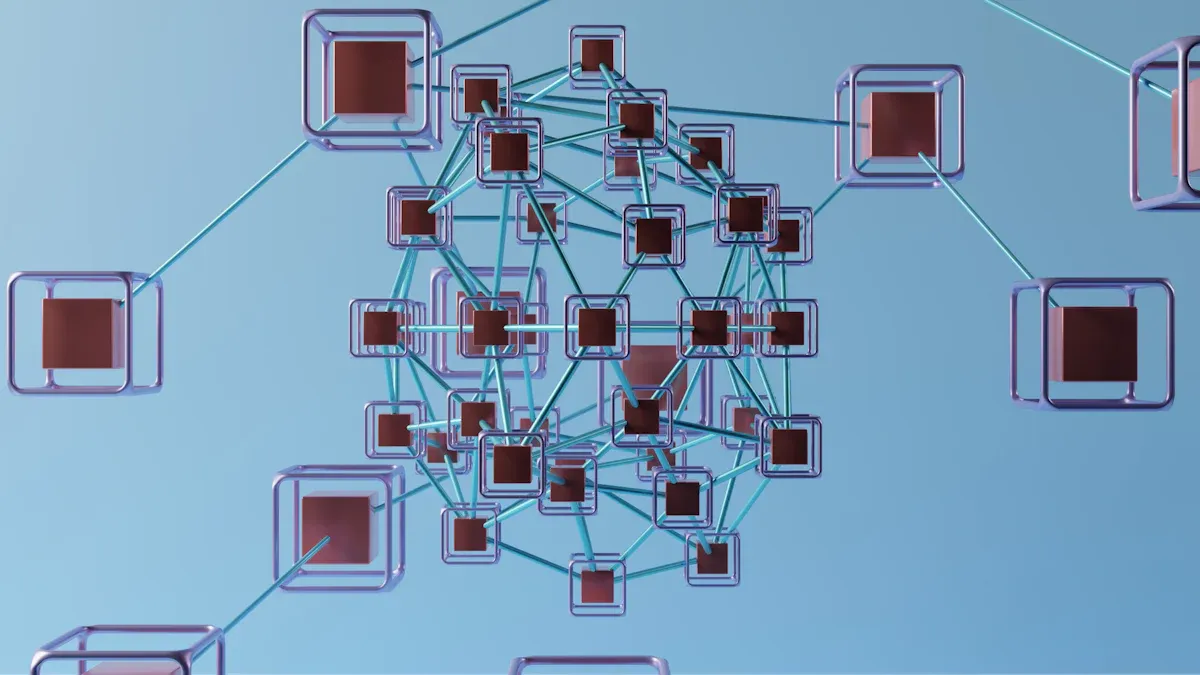
Integrating Disparate Business Systems in 2025 means you stay ahead and avoid major setbacks. Disconnected systems can slow you down and create problems for your business.
You might face slow, manual processes that delay your work.
Decisions can become inaccurate, leading to too much or too little inventory.
Updates get missed, and risk management suffers.
Mistakes happen more often, and customers lose trust.
Growth becomes harder, and you risk losing orders or revenue.
You need strong integration to boost efficiency, protect data, and prepare for the future.
Key Takeaways
ETL integration helps unify data from different sources, improving accuracy and decision-making. Follow the steps: extract, transform, and load data for better business insights.
Event-driven architecture allows real-time communication between systems. Identify key events in your processes to enhance responsiveness and streamline operations.
The AMCS Platform offers a complete solution for integrating business systems, especially in waste management. It simplifies operations and improves efficiency by connecting billing, dispatch, and inventory.
Assess your current systems to identify gaps and engage your team in the integration process. This collaboration leads to smoother transitions and better outcomes.
Automate processes and utilize integration experts to enhance productivity. Integrated systems lead to faster service, better inventory management, and improved teamwork.
1. ETL Integration

What Is ETL?
ETL stands for Extract, Transform, Load. You use ETL to move data from many sources into one place. This process helps you gather raw data, clean it, and store it for easy access.
Here are the main components of ETL:
Component | Description |
|---|---|
Extract | Gathering data from various sources, including databases and applications, in its raw format. |
Transform | Cleaning and preparing the data for analysis, including standardizing formats and correcting errors. |
Load | Loading the transformed data into a target system, such as a data warehouse, for reporting and analysis. |
Integrating Disparate Business Systems with ETL
You can use ETL integration to connect disparate business systems. For example, you might have sales, inventory, and finance data in separate software. ETL lets you pull all this information together. You create a unified system that supports streamlined operations and better decision-making. Many large enterprises rely on ETL, with a market share of 68%. Small and medium businesses are also adopting ETL quickly because it helps them grow.
Implementation Steps
You follow these steps to integrate disparate business systems using ETL:
Extract data from each system.
Clean and transform the data to match your needs.
Load the data into a central repository or data warehouse.
This method helps you create an integrated solution that supports business system integration.
Benefits
ETL integration gives you enhanced data accuracy and consistency. One company saw a 40% drop in data errors after automating ETL workflows. You get a single source of truth, which means you trust your data. You also save costs by reducing manual work and errors. Integrating business systems with ETL helps you make faster, better decisions.
Challenges
You may face some challenges when you integrate disparate business systems with ETL:
Challenge | Description |
|---|---|
Long-Term Maintenance | You need to keep ETL processes updated as your data sources change. |
End-User Requirements | You must consider what your users need from the data. |
Underestimating Data Transformations | You may find it hard to change data from many sources. |
Tightly Coupled Data Pipeline Components | If your ETL steps depend too much on each other, it gets harder to fix or scale. |
Not Identifying Warning Signs | Missing early problems can lead to bigger issues later. |
Best Practices
Follow these tips for success with ETL integration:
Minimize data input for faster results.
Use incremental updates to add only new data.
Maximize data quality by cleaning data before loading.
Automate ETL processes to reduce errors.
Handle ETL errors quickly to keep data reliable.
Optimize performance to avoid slowdowns.
Work together with your team for better integration.
ETL integration is one of the most effective ways for integrating disparate business systems. You can connect disparate systems, reduce costs, and achieve success with different integration methods.
2. Event-Driven Architecture

What Is Event-Driven Architecture?
Event-driven architecture (EDA) is a way to connect disparate business systems by using events to trigger actions. You set up your systems so that when something important happens, like a new order or a change in inventory, an event gets sent out. Other systems listen for these events and respond right away. This approach helps you achieve successful system integration and supports real-time reporting.
72% of global businesses now use event-driven architecture at different levels.
Only 13% have reached full enterprise-wide adoption.
Business System Integration in Real Time
You can use EDA to integrate order processing and inventory management. When a customer places an order, your order system sends an event. The inventory system receives this event and updates stock levels instantly. This process creates unified systems and streamlined operations.
Evidence | Explanation |
|---|---|
EDA relies on asynchronous communication, where events trigger interactions between loosely coupled components. | This enables real-time responsiveness and high scalability, crucial for communication between disparate systems. |
Event-driven architecture promotes loose coupling of applications through an event broker. | This allows for efficient routing of events from producers to consumers, facilitating real-time communication. |
EDA provides businesses with a highly flexible, scalable, and efficient way to design systems that can respond in real-time to changes. | This flexibility is essential for integrating various business systems and ensuring they can communicate effectively in real-time. |
Event-driven architecture enables real-time communications between systems and services across environments and geographies.
It enhances system responsiveness, scalability, and speed, ensuring faster adaptation to business changes.
Implementation Steps
You can follow these steps for integrating business systems using EDA:
Identify key events in your business processes.
Set up event producers to send out events.
Use event brokers to route events to the right consumers.
Configure event consumers to respond to events.
Monitor and test your integrated solution for enhanced data accuracy.
Benefits
EDA offers many benefits for integrating disparate business systems:
Benefit | Description |
|---|---|
Agility | Promotes faster deployments and reliable products. |
Flexibility | Reduces downtime and single points of failure. |
Scalability | Supports infinite scalability through event triggering. |
Real-time responsiveness | Enables instant event detection and response. |
Loose coupling | Allows independent component communication. |
Fault tolerance | Maintains system operation despite component failures. |
Event sourcing | Provides a complete record of actions for auditing. |
Extensibility | Facilitates integration with external services. |
Security and privacy | Implements robust security measures. |
Asynchronous processing | Improves performance by handling events independently. |
Analytics | Collects data for insights and optimization. |
Reduced resource consumption | Enhances server efficiency. |
Challenges
Stuff comes in, doesn’t come out. Things appear that you cannot explain where they came from. The amount of telemetry you have to add on your own to make those things sane is absolutely ridiculous in 2025.
Almost 40% of businesses believe that educating non-technical staff on the benefits of event-driven architecture is a major hurdle.
Network problems can cause event consumers to receive events out of order.
Event consumers must consider handling events out of order.
Best Practices
Ensure events are well-named and identifiable, using consistent naming conventions and unique event IDs.
Avoid creating excessive events to prevent system complexity.
Decouple components using event brokers for independent operation.
Carefully choose message delivery semantics to manage inconsistencies.
Select a messaging framework that supports your delivery semantics.
Implement monitoring, logging, and error handling for system reliability.
Continuously test your architecture to manage asynchronous workflows and eventual consistency.
Choosing the right integration approach, such as event-driven architecture, helps you streamline processes, increase efficiency, and reduce costs. You can achieve effective system integration and success by connecting disparate business systems with EDA. This method supports efficient operations and helps you build integrated solutions for different integration methods.
3. AMCS Platform
What Is the AMCS Platform?
You can use the AMCS Platform as a complete integrated solution for integrating disparate business systems, especially in the waste and recycling industry. This platform brings together your core processes, so you do not need to manage separate tools for billing, dispatch, or inventory. You get a single system that helps you see all your data in one place and make better decisions.
Feature | Description |
|---|---|
Replaces disparate systems with a single platform managing core business areas. | |
Data Accessibility | Ensures data is readily accessible and easy to understand. |
Automation Opportunities | Increases opportunities for automation, such as online self-service portals and automatic work order creation. |
Inventory Management | Automatically records stock, work in progress, and finished goods, supporting adjustments and reporting. |
Enhanced Efficiency | Streamlines operations, helping to identify cost savings and optimize collection routes. |
Integrating Disparate Business Systems with AMCS
You can integrate your disparate business systems using the AMCS Platform. The platform connects your billing, dispatch, and inventory management into one workflow. For example, the Municipality of Anchorage used the AMCS Platform to reduce operational costs, improve asset use, and gain insights into business growth. They now enjoy more reliable waste and recycling services, with better curbside collection and smoother landfill operations.
Implementation Steps
To start your integration journey with AMCS, follow these steps:
Assess your current systems and data sources.
Plan your migration to the AMCS Platform.
Use the AMCS API Accelerator Programme to connect your existing software. This program gives you templates, a safe testing sandbox, and direct access to technical support, making integration faster and easier.
Train your staff and monitor the new system for success.
Benefits for Disparate Systems
The AMCS Platform offers many benefits for business system integration:
Benefit | Description |
|---|---|
The platform grows with your business, handling more data and transactions. | |
Performance | You keep high performance, even as your business expands. |
Flexibility | You can add new features or modules as needed. |
You automate tasks like billing and reporting, which frees up staff time.
Your team can focus on more meaningful work, increasing job satisfaction.
You deliver better service to your clients and manage your operations more effectively.
Challenges
You may face some challenges when you integrate disparate business systems with AMCS:
Managing processes through multiple systems can make data exchange and reporting hard.
Data migration can be complex during the move to a unified platform.
Employee resistance to new technology is common. About 60% of organizations report this as a major challenge.
Training and engaging your staff early is key for success.
Best Practices
Involve your team from the start and explain the benefits of integration.
Use the AMCS API Accelerator Programme to speed up the process and reduce costs.
Provide clear training and support to help staff adapt.
Monitor your system and gather feedback to improve your integrated solution.
By choosing the AMCS Platform, you can increase efficiency, reduce costs, and achieve success in integrating disparate business systems.
You have learned three proven methods for integrating disparate business systems: ETL integration, event-driven architecture, and the AMCS Platform. These approaches help you boost efficiency, cut costs, and improve productivity. Companies that use integrated systems see faster lead times, better inventory management, and stronger teamwork.
Assess your current systems by gathering information, analyzing gaps, and engaging your team.
Take action by automating processes and connecting your workforce for real-time results.
Consult integration experts or explore the AMCS Platform to future-proof your business.
FAQ
What is the main benefit of integrating business systems?
You gain faster access to information. This helps you make better decisions. You also reduce mistakes and save time. Your team works together more easily.
How does integration help with improved customer experience?
You respond to customer needs faster. You keep information up to date. This means fewer errors and quicker service. Customers notice the difference.
Can small businesses use these integration methods?
Yes, small businesses can use ETL, event-driven architecture, or the AMCS Platform. These methods scale to fit your needs. You do not need a large IT team.
What is the first step to start integration?
You should review your current systems. List what you use and where you see problems. This helps you choose the best integration method.
How long does it take to see results from integration?
You often see results in a few weeks. Simple integrations work quickly. More complex projects may take longer, but you notice improvements as soon as systems connect.
